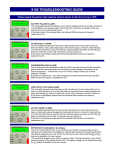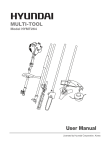Download Notes for the User PV
Transcript
Solar PV – Notes for the User Basic System Information You have just become a user of the most important energy source of the future – and yet the oldest one in existence. Correctly installed, it will provide many years of reliable service. Solar photovoltaic (PV) systems use PV cells to convert solar radiation into electricity. PV cells are connected together to form a panel. Panels are then linked and sized to meet a particular requirement. When light shines on the panel it creates an electric field across the layers of the cells, causing electricity to flow. The greater the intensity of the light, the greater the flow of electricity. The result is a PV array which supplies DC power to an inverter. The inverter, in turn, provides an AC power supply to the building. If the building has mains electricity, after notifying the Distribution Network Operator (DNO) of the installation, it is possible to export any excess electricity to the national grid. Please refer to the commissioning sheet for a list of the key components installed and the G83 application form required for notifying the DNO. Important Information Start-up Procedure The PV system has two forms of isolation, AC and DC Turn on DC isolator (PV array output) Turn on the AC isolator (grid connection) Check inverter operations (LED’s, status indicators) Shutdown Procedure The PV system has two forms of isolation, AC and DC Turn off the AC isolator (grid connection) Turn off DC isolator (PV array output) Confirm with a proprietary test lamp or two pole voltage detector isolation is complete Ensure there is no foreseeable risk that the supply could be reinstated by others Inverter Protection Settings The inverter(s) is programmed that automatic protection operates at: Operating voltage greater than 264 V phase to neutral Operating voltage less than 207 V phase to neutral Operating over frequency greater or lesser (0.5%) than 50.5 Hz Operating under frequency greater or lesser (0.5%) than 47 Hz Reconnection time: 180secs minimum Please refer to the system schematic for the actual inverter protection settings. Cleaning Recommendations The array depending on the location and inclination may suffer from dust, dirt, salt water if near the coast etc so cleaning the modules on a regular basis depending on the amount of soiling will be required. Soiling can cause a decrease of 10-15% in the output. The obvious danger is working at heights. Refer to working at heights documents. Care should be taken when cleaning the module so as not to remove the anti-reflection coating as this will affect the output of the modules Procedure for Verifying Correct System Operation Solar PV – Notes for the User Monitoring the system provides a good way of verifying correct system operation. Monitoring can be as simple as noting down the output of the PV system once a month and comparing it against the expected output. A significant difference must be investigated as a possible problem. This allows the operator to locate faulty or problematic panels before significant power generation is lost. *Please refer to Inverter User Manual for LED display operation settings. Troubleshooting Symptom No display on inverter Possible cause Loss of AC No DC generation DC isolator switched off String fuse blown Diode Blown Broken DC cable Lack of full DC output Aged modules Shading Dirt or debris on module Bad DC connection Remedy Reset MCB or Fuse Switch on AC circuit switches Switch on DC isolator Replace fuse after rectifying fault Replace diode or module Repair cable after identifying and dealing with any underlying fault Replace modules (if required) Remove (where possible) shading Clean module Repair DC connector PV Maintenance Recommendations Verification that the array fixings are still in a suitable condition Verification that any roof penetrations are still watertight Verification of the condition of the DC supply cables Check the inverter data log (where possible) to verify actual output against what might be expected An inspection of the PV modules should be made for physical damage, the entrance of water into the module, delamination or any form of degradation of cell connections. The mounting system should be inspected for corrosion or weakness. The weather sealing of the roof penetrations must also be checked. Check that shading is still not affecting the array, for example: New buildings causing shading Dirt or debris covering the modules Growth of trees or hedges locally that may affect the arrays collection Considerations for any future building works adjacent to the PV array (eg roof works) to avoid potential damage or shading of the PV array AC electrical installation periodic inspection report as per BS 7671, latest edition After carrying out maintenance, a PV array test report should be completed for the array(s) and handed over to the client as well as any AC inspection reports that may have been completed.









